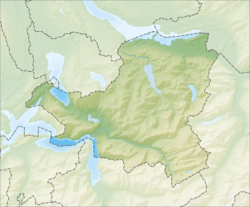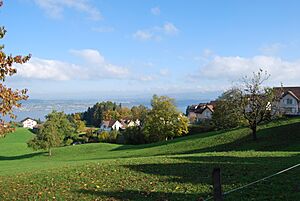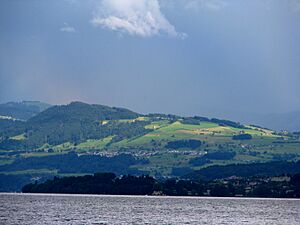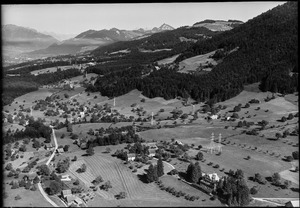Feusisberg facts for kids
Quick facts for kids
Feusisberg
|
||
|---|---|---|
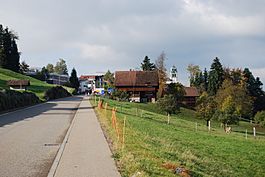 |
||
|
||
| Country | Switzerland | |
| Canton | Schwyz | |
| District | Höfe | |
| Area | ||
| • Total | 17.5 km2 (6.8 sq mi) | |
| Elevation | 685 m (2,247 ft) | |
| Population
(Dec 2020 )
|
||
| • Total | 5,427 | |
| • Density | 310.1/km2 (803.2/sq mi) | |
| Postal code |
8835
|
|
| Localities | Biberbrugg, Schindellegi | |
| Surrounded by | Einsiedeln, Freienbach, Hütten (ZH), Oberägeri (ZG), Wollerau | |
Feusisberg is a town, also known as a municipality, located in the Höfe District in the canton of Schwyz in Switzerland. It's a beautiful place with great views.
Contents
A Look Back: Feusisberg's History
Feusisberg was first mentioned a very long time ago, in the 1200s! Back then, it was simply called Berg or Uffenberg. Later, in the 1500s, its name changed to Fessisskilch. By 1590, it was known as Föussisberg, which is very close to its current name.
Exploring Feusisberg's Geography
Feusisberg covers an area of about 17.5 square kilometers (about 6.7 square miles). Almost half of this land (48.8%) is used for farming. A large part (41.2%) is covered by forests. The rest of the land has buildings and roads (8.6%), or is made up of rivers and mountains (1.4%).
The town sits on a flat area below the Etzel mountain. It looks out over Lake Zurich. Its elevation is between 600 and 800 meters (about 1,968 to 2,624 feet) above sea level. Feusisberg includes the villages of Feusisberg and Schindellegi, plus a part of Biberbrugg. In 2000, about two-thirds of the people in the municipality lived in Schindellegi.
Understanding Feusisberg's Population
Feusisberg has a population of 5,427. In 2007, about 20% of the people living here were from other countries. Over the past 10 years, the population has grown quite a bit, by about 32.8%. In 2000, most people (91.1%) spoke German.
In 2008, about 23.3% of the population was under 19 years old. About 28.7% were between 20 and 39, and 35.5% were between 40 and 64. Older adults, aged 65 and above, made up about 12.5% of the population.
In 2000, there were 1,577 homes in Feusisberg. About 31.1% of these homes had only one person living in them. About 5.3% were larger homes with five or more people.
In the 2007 election, the most popular political group was the SVP, which got 46.6% of the votes. Other popular groups included the FDP (22.8%), the CVP (13.5%), and the SPS (12.5%).
Many adults in Feusisberg have a good education. About 74.2% of people aged 25 to 64 have finished high school or gone on to higher education, like university.
Feusisberg has a low unemployment rate of 1.55%. In 2005, many people worked in different areas:
- Primary sector: 199 people worked in farming or other basic industries.
- Secondary sector: 444 people worked in manufacturing or construction.
- Tertiary sector: 1,010 people worked in services, like shops or offices.
In 2000, most people in Feusisberg were Roman Catholic (62.0%) or belonged to the Swiss Reformed Church (20.7%). A smaller number of people belonged to other Christian churches, the Orthodox Church, or were Islamic. Some people did not belong to any church.
The table below shows how the population of Feusisberg has changed over time:
| year | population |
|---|---|
| 1743 | 649 |
| 1850 | 991 |
| 1900 | 1,276 |
| 1950 | 1,654 |
| 1970 | 2,173 |
| 1980 | 2,833 |
| 1985 | 2,951 |
| 1990 | 3,178 |
| 2000 | 3,765 |
| 2005 | 4,291 |
| 2007 | 4,593 |
Getting Around: Transportation in Feusisberg
The town is located right on the A3 motorway, which is a major highway. There are also two train stops in the municipality: Biberbrugg station and Schindellegi-Feusisberg station. These stations are served by the Zurich S-Bahn train lines S13 and S40. Biberbrugg station also has service from the Voralpen Express, which is a scenic train route.
See also
 In Spanish: Feusisberg para niños
In Spanish: Feusisberg para niños




